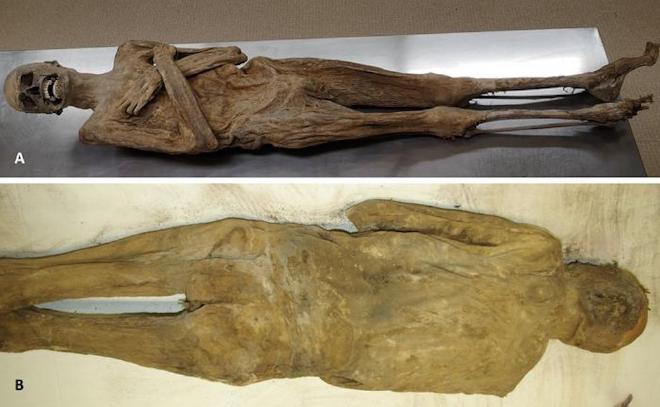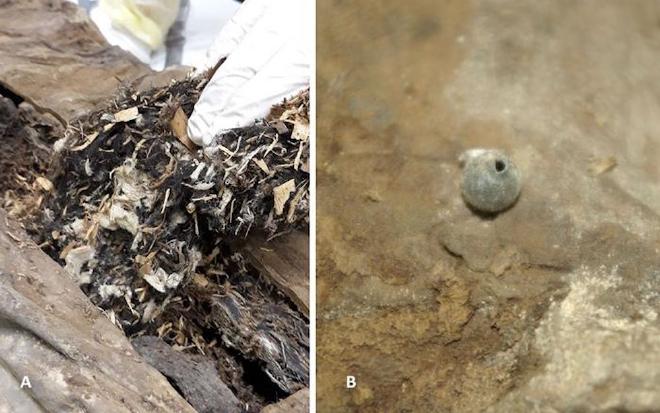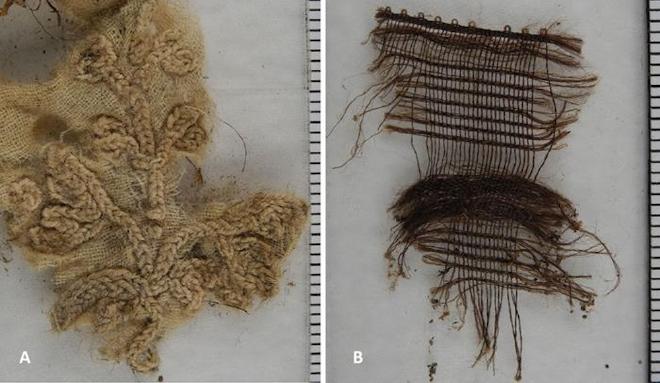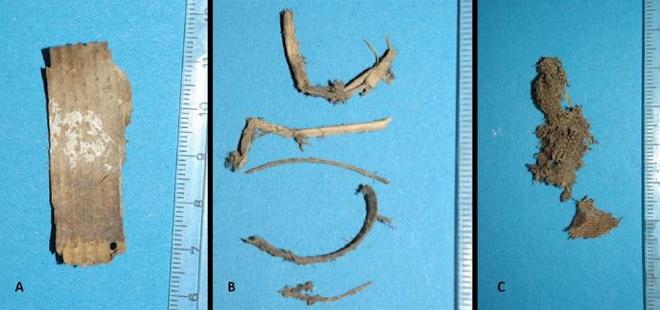

For centuries, many cultures around the world embalmed their dead, often for religious reasons. Accordingly, embalming methods differ, but not all of them are studied equally well.
In a first report of a previously undocumented embalming method, an international team of researchers has analyzed a mummy from a small Austrian village. Detailed analyses provided insights into little-known mummification techniques and allowed them to identify the body.

“The unusually well-preserved mummy in the church crypt of St Thomas am Blasenstein is the corps of a local parish vicar, Franz Xaver Sidler von Rosenegg, who died in 1746,” said Dr Andreas Nerlich, a pathologist at Ludwig-Maximilians-Universität and first author of the Frontiers in Medicine article. “Our investigation uncovered that the excellent preservation status came from an unusual type of embalming, achieved by stuffing the abdomen through the rectal canal with wood chips, twigs and fabric, and the addition of zinc chloride for internal drying.”
A different type of embalming #
The team conducted extensive analyses, including CT scanning, focal autopsy, and radiocarbon dating. The mummy’s upper body was fully intact, whereas lower extremities and head showed considerable post-mortem decay.

The researchers believe it is this mixture of materials that kept the mummy in such good condition. “Clearly, the wood chips, twigs, and dry fabric absorbed much of the fluid inside the abdominal cavity,” said Nerlich. Next to these absorbents, a toxicological analysis showed traces of zinc chloride, which has a strong drying effect.

This way of embalming is different to better-known methods where the body is opened to prepare it. Here, however, the embalming materials were inserted via the rectum. “This type of preservation may have been much more widespread but unrecognized in cases where ongoing postmortal decay processes may have damaged the body wall so that the manipulations would not have been realized as they were,” Nerlich pointed out.
Tracing a life #
The mummy was long rumored to belong to Sidler, but the origin of these rumors is unknown. It was, however, only the current investigation that provided certainty as to its identity. “The identification of the mummy comes from our interdisciplinary analysis, especially with the radiocarbon dating, his body activity pattern, and the stable isotope pattern,” Nerlich said.

“We have some written evidence that cadavers were ‘prepared’ for transport or elongated laying-out of the dead – although no report provides any precise description,” Nerlich concluded. “Possibly, the vicar was planned for transportation to his home abbey, which might have failed for unknown reasons.”
Abstract #
The multidisciplinary study of the well preserved cadaver of the so-called “air-dried chaplain” from the church crypt of St. Thomas am Blasenstein (Upper Austria) not only solved the “mystery” of the excellent preservation of the trunk of this unusual mummified human body, but also provided circumstantial information about this historic individual, his life and disease history, and conclusion of his cause of death. The mummy of a 35–45 year old male, radiocarbon dated to the period 1730–1780 CE is most likely that of the local aristocratic parish vicar Franz Xaver Sidler von Rosenegg who had been temporarily delegated to St. Thomas parish from his mother monastery of Waldhausen im Strudengau (Upper Austria). He had a high-quality diet based on terrestrial animal products, showed no signs of major physical work load, was most likely a pipe smoker and suffered from chronic active pulmonary tuberculosis with peripheral and central (hilar) calcifications (primary tuberculous complex) and a right lower lobe cavity with focal heterotopic ossification and potential active inflammation. This latter may have caused acute pulmonary hemorrhage which may have been the cause of death. Most surprisingly, we detected, in the otherwise completely intact abdominal (and pelvic) cavity, extensive packing with foreign material which was identified as a mixture of wood chips, fragmented twigs, large amounts of fabric of various types including elaborate embroidered linen, and even pieces of silk. Furthermore, this embalming method seems to have included high level zinc-ion solution impregnation (most likely zinc-chloride with small amounts of arsenic) and the addition of copper. The packing was inserted into the abdominal body cavity through the rectum. It led to an excellent state of conservation of the trunk, while the face (and skull) and peripheral extremities were less well preserved.
-
The paper The Mystery of the “Air-dried Chaplain” solved: the Life and “Afterlife” of an unusual Human Mummy from 18 th century Austria was published in **Frontiers in Medicine**. Authors: Andreas G. Nerlich, Peter Hofer,Stephanie Panzer, Christine Lehn, Judith Wimmer, Oskar Nowak, Frank Musshoff & Oliver K. Peschel.
-
The article Centuries-old Austrian mummy found to be exceptionally well preserved thanks to unusual embalming method edited by Deborah Pircher was published in **Frontiers**
-
COI Statement
The authors declare that the research was conducted in the absence of any commercial or financial relationships that could be construed as a potential conflict of interest. -
Funding
The author(s) declare that no financial support was received for the research and/or publication of this article.
Acknowledgments
The authors said: We are deeply indebted for the help with this study: to Kerstin Gonda, Dipl-Biol, and Karl Lüftl, Bavarian Criminal Police Department, Munich, for their generous help with the material analysis; Monsignore Karl Wögerer, parish of Waldhausen im Strudengau (Upper Austria) for kindly providing us with important data from the unpublished report about the mummy investigation from 2000 that had been commissioned by the local parish. The local parish committee and the diocese Linz for the permission to perform this study; Dr. Christian Hamann, Leibniz-Laboratory for Radiometric Dating and Isotope Research, Kiel University (Germany) for the radiocarbon dating, and Prof. Simon Donell, Norwich Medical School, for correction of the English version of this manuscript.
-
Institutions involved
-
Institute of Legal Medicine, Ludwig-Maximilians University Munich, Munich, Germany
-
Institute of Legal Medicine, Medical University Graz, Graz, Austria
-
Diagnostic and Research Institute of Forensic Medicine, Medical University Graz, Graz, Austria
-
Department of Radiology, Paracelsus Medical University, Salzburg, Austria
-
Department of Art and Heritage Conservation, Diocese Linz, Linz, Austria
-
Institute of Human Biology and Evolution, Faculty of Biology, Adam Mickiewicz University, Poznań, Poland
-
Forensic Toxicological Centre (FTC), Munich, Germany
-
Generative AI statement
The author(s) declare that no Gen AI was used in the creation of this manuscript.

